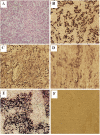Characteristics of epstein barr virus variants associated with gastric carcinoma in Southern Tunisia
- PMID: 22047541
- PMCID: PMC3216291
- DOI: 10.1186/1743-422X-8-500
Characteristics of epstein barr virus variants associated with gastric carcinoma in Southern Tunisia
Abstract
Background: EBV-associated Gastric Carcinoma (EBVaGC) has a distinct clinical features and its prevalence is variable worldwide.
Results: To determine the prevalence of EBVaGC in Tunisia, EBV-encoded small RNA (EBER) expression was assessed in 81 gastric carcinoma (GC) specimens. The nuclear EBER expression was detected in 12 out of 81 GC cases (14.81%) and concordance between the score range of EBER staining and the number of EBV DNA copies as estimate by QPCR is observed. On the other hand, we found that EBVaGC strongly correlated with age at diagnosis, and weakly with tumor differentiation and venous invasion.Furthermore, the EBVaGC specimens were subjected to determine the EBV DNA polymorphisms. Our results show a unique genetic profile of the EBV strains regarding the A and D types, the F prototype, the retention of XhoI restriction site and the 30 bp del-LMP1 variant. According to our previous studies on nasopharyngeal carcinoma (NPC), we suggested that EBV strains associated to GC and NPC shared some similarities in Tunisian patients.
Conclusion: The prevalence of EBVaGC is of 14.81% in the southern Tunisia and that common EBV strain are associated with both NPC and GC which are likely to differ from Asian strains. Our findings support therefore a certain geographical distribution of EBV strains which is not restricted to EBV-associated malignancies.
Figures




References
-
- Yustein AS, Harper JC, Petroni GR, Cummings OW, Moskaluk CA, Powell SM. Allelotype of gastric adenocarcinoma. Cancer Resv. 1999;59:1437–1441. - PubMed
-
- Hsairi M, Fakfakh R, Ben Abdallah M, Jelidi R, Sellami A, Nacef T. Assessment of cancer incidence in Tunisia. La Tunisie Médicale. 2002;80:57–64. - PubMed
Publication types
MeSH terms
Substances
LinkOut - more resources
Full Text Sources
Medical
Miscellaneous

